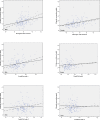Association of C-peptide and lipoprotein(a) as two predictors with cardiometabolic biomarkers in patients with type 2 diabetes in KERCADR population-based study
- PMID: 35609059
- PMCID: PMC9128999
- DOI: 10.1371/journal.pone.0268927
Association of C-peptide and lipoprotein(a) as two predictors with cardiometabolic biomarkers in patients with type 2 diabetes in KERCADR population-based study
Abstract
We sought association between serum Lipoprotein(a) and C-Peptide levels as two predictors with cardiometabolic biomarkers in patients with type 2 diabetes mellitus. This nested case-control study was conducted on 253 participants with type 2 diabetes mellitus and control from the second phase of the KERCADR cohort study. The participants were randomly allocated into case and control groups. The quantitative levels of Lipoprotein(a) and C-Peptide were measured by ELISA. Atherogenic indices of plasma were measured. The plasma Atherogenic Index of Plasma significantly decreased (P = 0.002) in case-male participants, and plasma Castelli Risk Index II level significantly increased (P = 0.008) in control-male participants with the highest dichotomy of Lipoprotein(a). The plasma Atherogenic Index of Plasma level in case-female participants significantly increased (P = 0.023) with the highest dichotomy of C-Peptide. Serum C-Peptide level significantly increased (P = 0.010 and P = 0.002, respectively) in control-male participants with the highest dichotomies of Atherogenic Index of Plasma and Castelli Risk Index I. There was a significant association between the highest quartile of C-Peptide and higher anthropometric values in case participants; and higher atherogenic indices of plasma and anthropometric values in control participants. Raised serum C-peptide than raised Lipoprotein(a) can be a prior predictor for cardiometabolic disease risk in healthy participants and patients with type 2 diabetes mellitus with increased cardiometabolic biomarkers. Case and control males with general and visceral obesity and case and control females with visceral obesity are exposure to increased C-peptide, respectively. Lipoprotein(a) may be risk independent biomarker for type 2 diabetes mellitus. Reducing raised Lipoprotein(a) levels to less than 30ng/ml with strict control of low density lipoprotein cholesterol would be the best approach to prevent coronary artery disease consequences. It is suggested that a screening system be set up to measure the Lp(a) levels in the community for seemingly healthy people or individuals with one or more cardiometabolic biomarkers.
Conflict of interest statement
No potential conflict of interest relevant to this article was reported.
Figures


Similar articles
-
Associations between serum vitamin D3, atherogenic indices of plasma and cardiometabolic biomarkers among patients with diabetes in the KERCADR study.BMC Endocr Disord. 2022 May 12;22(1):126. doi: 10.1186/s12902-022-01043-1. BMC Endocr Disord. 2022. PMID: 35549686 Free PMC article. Clinical Trial.
-
Association between remnant lipoprotein cholesterol levels and non-alcoholic fatty liver disease in adolescents.JHEP Rep. 2020 Jul 24;2(6):100150. doi: 10.1016/j.jhepr.2020.100150. eCollection 2020 Dec. JHEP Rep. 2020. PMID: 32984791 Free PMC article.
-
Cholesterol and glucose profiles according to different fasting C-peptide levels: a cross-sectional analysis in a healthy cohort from the Czech Republic.J Appl Biomed. 2021 Dec;19(4):220-227. doi: 10.32725/jab.2021.023. Epub 2021 Oct 13. J Appl Biomed. 2021. PMID: 34907741
-
Beyond low-density lipoprotein: addressing the atherogenic lipid triad in type 2 diabetes mellitus and the metabolic syndrome.Am J Cardiovasc Drugs. 2005;5(6):379-87. doi: 10.2165/00129784-200505060-00005. Am J Cardiovasc Drugs. 2005. PMID: 16259526 Review.
-
Lipoprotein abnormalities and their consequences for patients with type 2 diabetes.Diabetes Obes Metab. 2003 Nov;5 Suppl 1:S19-27. doi: 10.1046/j.1462-8902.2003.0310.x. Diabetes Obes Metab. 2003. PMID: 14984018 Review.
Cited by
-
The bidirectional association of C-peptide with cardiovascular risk in nondiabetic adults and patients with newly diagnosed type 2 diabetes mellitus: a retrospective cohort study.Cardiovasc Diabetol. 2022 Oct 3;21(1):201. doi: 10.1186/s12933-022-01636-z. Cardiovasc Diabetol. 2022. PMID: 36192784 Free PMC article.
-
Lipoprotein(a), Cardiovascular Events and Sex Differences: A Single Cardiological Unit Experience.J Clin Med. 2023 Jan 18;12(3):764. doi: 10.3390/jcm12030764. J Clin Med. 2023. PMID: 36769413 Free PMC article.
References
Publication types
MeSH terms
Substances
LinkOut - more resources
Full Text Sources
Medical
Miscellaneous

